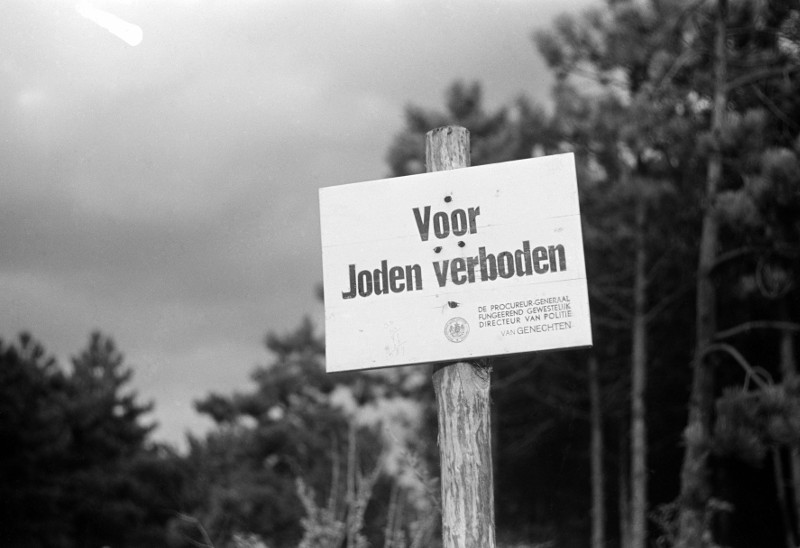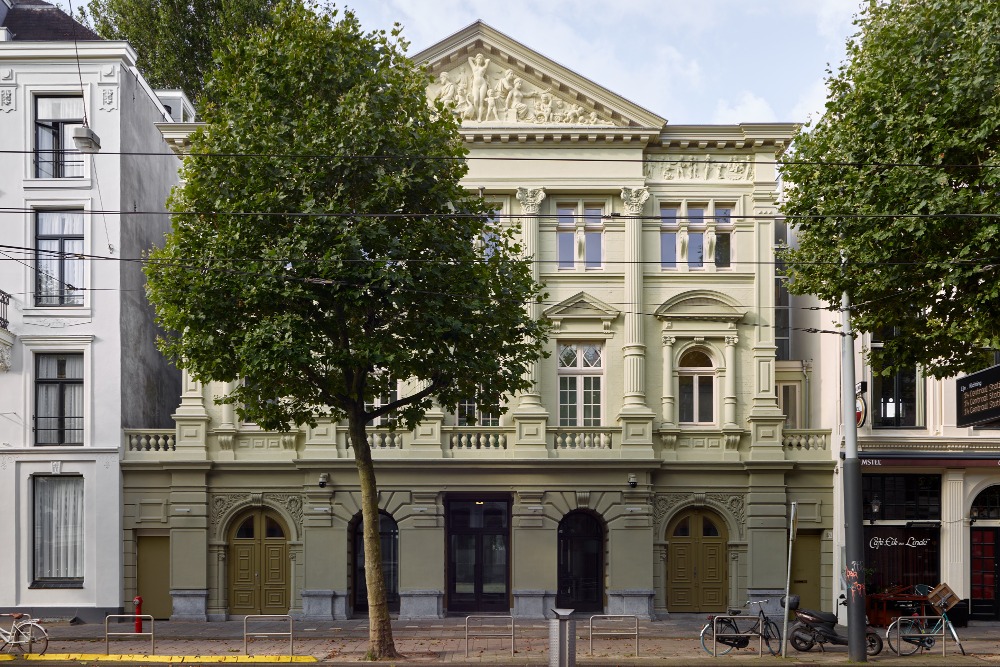| 01/07/1940 | Jews prohibited from working in the air protection service. |
| 06/09/1940 | Jews prohibited from being employed in the civil service. Jews who already are
employed should not be promoted. This measure was, shortly after , extended from
departments and universities to all subsidized institutions. |
| 26/09/1940 | Prohibited to publish Jewish newspapers, except "Het Joodsche Weekblad". |
| 05/10/1940 | All employees at universities, departments and subsidized institutions have to fill out
an Aryan declaration about their origin. |
| 22/10/1940 | All Jewish businessmen had to have their company registered. The regulation controls,
in general terms, who is and who is not to be regarded as Jewish. Here, this description
is intended to ensure that the companies cannot easily be transferred to others.
This regulation, however, will later on widely be applied regarding deportations:
Everyone who has three or more Jewish grandparents and is a member of a Jewish
parish or is married to a Jew, will be considered as Jewish. |
| 04/11/1940 | Announcement that on November 21st, all Jewish officials will be suspended and, later
on, discharged. |
| 19/12/1940 | Jews prohibited from employing German household staff. |
| 09/01/1941 | Jews prohibited from visiting cinemas. |
| 10/01/1941 | All Jews or people with at least one Jewish grandparent must register at the population
registry. Within four weeks after the announcement, all municipalities have to make a
report, which is to be completed within the prescribed period. Only a few people
(twenty according to Dr. Lou de Jong) within the Jewish population refuse to cooperate.
Officially 160,820 Jews are registered, of which 15,549 were half- Jews and 5,719
quarter-Jews. |
| 16/01/1941 | For Amsterdam, the city where the vast majority of the Jewish population lives, an
additional measure is applied. They also need to specify how many houses and how
many stores are in the possession of Jewish people , where their schools and churches
are situated, what tram and bus services operate in these neighbourhoods and what
cultural institutions are available. |
| 12/02/1941 | The quarter in Amsterdam with many Jewish inhabitants is fenced in with barbed wire
and renamed the "Joodsche Wijk" (Jewish quarter). Shortly after, the barriers are taken
away, but the signs "Joodsche Wijk" remained in place. |
| 13/02/1941 | Establishment of the Jewish Council, which had been given the dubious order to
implement all German measures, including determining which group of Jews has to be
transported next and to nip all protests in the bud immediately.
The only Jewish newspaper, "Het Joodsche Weekblad" (the Jewish Weekly), was to be
used for this purpose. |
| 22/02/1941 | First arrests of 427 Jews who are deported to Mauthausen, after violent protests against
the measures. In response to this , the February strike breaks out, the one and only
strike against anti-Jewish measures in the entire war. |
| 15/04/1941 | Jewish people prohibited from having radios in their possession. |
| 01/05/1941 | Jewish lawyers and doctors are not allowed to have non-Jewish clients and patients. |
| 01/05/1941 | Jews are no longer allowed to visit markets. |
| 31/05/1941 | Jews are no longer allowed to visit swimming pools and beaches. |
| 11/06/1941 | Second deportation of 300 Jews from Amsterdam to Mauthausen. |
| 08/08/1941 | First LiRo (Lippman-Rosenthal) regulation VO 148/1941: Jews are obliged to transfer
their bank balances of more than a thousand guilders (about 450 euros) to the
Lippmann-Rosenthal Bank, a former Jewish bank, taken over by the Germans. |
| 01/09/1941 | Jewish children are not allowed to go to public schools. |
| 14/09/1941 | Third roundup in Twente; hundreds of Jewish men were arrested and deported. |
| 15/09/1941 | Prohibited for Jews to visit parks, zoos, cafés, restaurants, hotels, theatres and
museums. |
| 18/09/1941 | Fourth roundup in Gelderland; hundred Jews are arrested and deported. |
| 09/01/1942 | Jewish identity cards have to be provided with a "J". |
| 10/01/1942 | Labour camps for Jews are set up in the east and north of the country. |
| 20/03/1942 | Prohibited for Jews to possess or to drive any means of transport. |
| 26/03/1942 | Prohibited for Jews to marry non-Jews. |
| 03/05/1942 | All Jews over six years of age have to wear a yellow six-pointed Star of David with the
word "Jew", clearly visible their clothing. |
| 21/05/1942 | Second LiRo Regulation VO 58/1942: Jews are obliged to hand in all their gold, silver,
antiques, art, and cultural valuables at Lippmann-Rosenthal in the Sarphati street in
Amsterdam. |
| 12/06/1942 | Jews are only allowed to shop in a limited number of stores during a limited
period of time. |
| 30/06/1942 | Setting of a curfew. Jews must be at home between 20.00 and 06.00 hours. |
| 05/07/1942 | First summons of the Jewish Council are distributed. |
| 06/07/1942 | Prohibited for Jews to phone and to pay visits to non-Jews. |
| 14/07/1942 | First transport of Amsterdam Jews to transit camp Westerbork. |
| 15/07/1942 | The first train with 1,135 Jews leaves from Westerbork to Auschwitz. Until September
13th, 1944, a train will be going to Auschwitz or Sobibor weekly. |
| 22/07/1942 | The Hollandsche Schouwburg is taken into service as a gathering place where the Jews
are to report themselves, and retrieved and arrested Jews are being held. |
| 01/10/1942 | Jews in Dutch labour camps are transferred to Westerbork. |
| 15/10/1942 | The crèche at the Plantage Middenlaan 31 is being used as an annex to the Hollandsche
Schouwburg. Jewish children, separated from their parents, are waiting to be deported. |
| 15/01/1943 | All foundlings are considered Jewish children, they are brought to the nursery in
Amsterdam and subsequently deported. |
| 16/01/1943 | The first group of 450 Jews is deported from the Hollandsche Schouwburg to labour
camp Vught. During the war, a total of 12,000 Jews will be imprisoned.
|
| 02/03/1943 | First transport from Westerbork to the new extermination camp Sobibor. |
| 15/03/1943 | The Germans found out that about 25,000 Jews were in hiding. During a
meeting in The Hague, Harster, Zopf and Lages decide to work with a premium system
to retrieve Jews in hiding. Harster sets the premium at seven guilders and fifty cents a
Jew, an amount that could be doubled if the Jewish arrestee had violated regulations. |
| 10/04/1943 | Prohibited for Jews to reside in the provinces Groningen, Friesland, Drenthe, Overijssel,
Gelderland, Zeeland, North Brabant and Limburg. |
| 22/04/1943 | Prohibited for Jews to reside in the provinces of Utrecht, South and North Holland,
except Amsterdam. With the introduction of these measures all Jews were in German
captivity, with the exception of a limited number of Amsterdam Jews, some with
exceptional exemption ("Sperre") and Jews in hiding. |
| 06/07/1943 | Children's transport from Westerbork to Sobibor. |
| 29/09/1943 | Transport of the last remaining Jews from Amsterdam to Westerbork. |
| 19/11/1943 | The Hollandsche Schouwburg closes after the last group of Jews, arrested out of hiding,
is deported. |
| 19/11/1943 | First transport from Westerbork to Theresiënstadt. |
| 11/01/1944 | First transport from Westerbork to concentration camp Bergen-Belsen. |
| 01/05/1944 | Introduction of the TD card, the "Tweede Distributiestamkaart" (second distribution
master card), in addition to the distribution map for the procurement of food, which had
been introduced in the Netherlands in 1939. The TD card was linked to the control of
identity cards in order to prevent Jews in hiding and members of the resistance from
getting food. Moreover it would be easier to track them down during their attempts to
do so. |
| 02/06/1944 | Last transport from camp Vught to Auschwitz. |
| 13/09/1944 | Last transport from Westerbork. |





